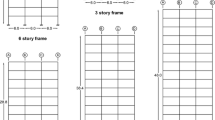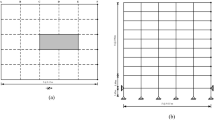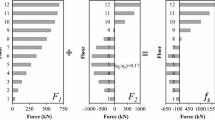Abstract
This paper presents an analytical study to investigate the seismic demand of Steel-Plate Shear Wall frames (SPSW) as a system for resisting lateral loads while subjected to the Permanent Tectonic Displacement effect (PTD). PTD is considered to be one of the main characteristics of near-fault ground motions in which one or more high-amplitude pulses with a large period in velocity records can be observed. To this end, the seismic response of SPSW frames as one of the reliable structural systems for mid-, and high-rise buildings in the form of 8-, 13-, and 18-storey frames were investigated using nonlinear dynamic analysis. Three distinctive sets of ground motions (GMs) were considered. Accordingly, a technique was used to identify the PTD effect with a sinusoidal pulse in the acceleration diagram. The results proved that the presence of PTD pulse may increase or decrease the structural demands regarding various parameters that were fully discussed in this study. As the height of the structure increases, the main factors of increasing the inelastic demand are the ratio of the structure period to the pulse period and the ratio of ap/PGA. For mid-rise SPSW, the high-frequency content plays a greater role in comparison with the period ratio. For the tallest structure, the maximum demand against the fling-step effect was observed for the Yarimca record where the ratio of ap/PGA was the highest (0.65). In addition, the period ratio (Tst/Tp) was the highest (0.73) among other records.

























Similar content being viewed by others
Abbreviations
- C :
-
Damping matrix
- K :
-
Stiffness matrix
- M :
-
Mass matrix
- X :
-
Displacement vector
- \(\dot{{\varvec{X}}}\) :
-
Velocity vector
- \(\ddot{{\varvec{X}}}\) :
-
Acceleration vector
- \({\ddot{{\varvec{x}}}}_{{\varvec{g}}}\) :
-
Ground shaking acceleration
- ap :
-
Pulse amplitude
- T st :
-
Period of the structure
- T p :
-
Period of the pulse signal
- T :
-
Fundamental period
- ζ :
-
Damping ratio
- \({\Omega }_{0}\) :
-
Over-strength factor
- \({R}_{u}\) :
-
Strength reduction factor
- \({c}_{d}\) :
-
Displacement amplification coefficient
- A:
-
Seismicity factor
- \({V}_{n}\) :
-
Shear strength of the plate
- \({t}_{w}\) :
-
Thickness of the web
- \({L}_{cf}\) :
-
Distance between columns
- α :
-
Angle of the sheet (angle of inclination)
- SPSW:
-
Steel-Plate Shear wall
- PTD:
-
Permanent tectonic displacement effect
- PGA:
-
Peak ground acceleration
- PGV:
-
Peak ground velocity
- PGD:
-
Peak ground displacement
- GMs:
-
Ground motions
- SDOF:
-
Single degree of freedom
- FE:
-
Finite element
- h :
-
Free height of the column
- L :
-
Length of the span
- \({\Delta t}_{w}\) :
-
Sheets thickness difference in the upper and lower of the beam
- n :
-
Number of strips
- \({I}_{c}\) :
-
Moment of Inertia of the vertical boundary elements
- \({A}_{c}\) :
-
Is cross-sectional area of the vertical boundary element
- \({A}_{b}\) :
-
Cross-sectional area of the horizontal boundary element
References
Abdollahzadeh GR, Ghobadi F (2015) Linked mathematical–informational modeling of perforated steel plate shear walls. Thin-Walled Struct 94:512–520
Nooralizadeh A, Naghipour M, Nematzadeh M, Zamenian H (2017) Experimental evaluation of steel plate shear walls stiffened with folded sheets. Int J Steel Struct 17:291–305
Xu T, Shao J-H, Zhang J-Y, Kaewunruen S (2019) Experimental performance evaluation of multi-storey steel plate shear walls designed by different methods. Int J Civil Eng 17:1145–1154. https://doi.org/10.1007/s40999-018-0374-0
Gholhaki M, Ghadaksaz MB (2016) Investigation of the link beam length of a coupled steel plate shear wall. Steel Compos Struct 20:107–125
Jalali SA, Amini A, Mansouri I, Hu JW (2021) Seismic collapse assessment of steel plate shear walls considering the mainshock–aftershock effects. J Construct Steel Res 182:106688
Khaloo A, Foroutani M, Ghamari A (2019) Influence of diagonal stiffeners on the response of steel plate shear walls (SPSWs) considering crack propagation. Bull Earthq Eng 17:5291–5312
Qureshi RK, Bruneau M (2019) Behavior of steel plate shear walls subjected to repeated synthetic ground motions. J Struct Eng 145:4019008
Hisada Y, Bielak J (2003) A theoretical method for computing near-fault ground motions in layered half-spaces considering static offset due to surface faulting, with a physical interpretation of fling step and rupture directivity. Bull Seismol Soc Am 93:1154–1168
Xie L, Xu L, Adrian R-M (2005) Representation of near-fault pulse-type ground motions. Earthq Eng Eng Vib 4:191
Xin L, Li X, Zhang Z, Zhao L (2019) Seismic behavior of long-span concrete-filled steel tubular arch bridge subjected to near-fault fling-step motions. Eng Struct 180:148–159
Kojima K, Fujita K, Takewaki I (2019) Double and triple impulses for capturing critical elastic-plastic response properties and robustness of building structures under near-fault ground motions. Resilient structures and infrastructure. Springer, Berlin, pp 225–242
Güneş N, Ulucan ZÇ (2019) Nonlinear dynamic response of a tall building to near-fault pulse-like ground motions. Bull Earthq Eng 17:2989–3013. https://doi.org/10.1007/s10518-019-00570-y
Tsai M-H, Jiang Z-Y, Yeh W-C (2021) Estimating the peak longitudinal near-field seismic response of an isolated bridge using basic pulse motions. Int J Civil Eng 19:789–803. https://doi.org/10.1007/s40999-021-00610-2
Somerville PG, Smith NF, Graves RW, Abrahamson NA (1997) Modification of empirical strong ground motion attenuation relations to include the amplitude and duration effects of rupture directivity. Seismol Res Lett 68:199–222
Moustafa A, Takewaki I (2010) Characterization and modeling of near-fault pulse-like strong ground motion via damage-based critical excitation method. Struct Eng Mech 34:755
Nicknam A, Barkhodari MA, Hamidi Jamnani H, Hosseini A (2013) Compatible seismogram simulation at near source site using multi-taper spectral analysis approach (MTSA). J Vibroengineering 15:626–638
Tarbali K, Bradley BA, Baker JW (2019) Ground motion selection in the near-fault region considering directivity-induced pulse effects. Earthq Spectra 35:759–786
Rouhi A, Hamidi H (2021) Development of performance based plastic design of EBF steel structures subjected to forward directivity effect. Int J Steel Struct 21:1092–1107
Abbaszadeh MA, Hamidi H, Amiri JV (2022) On seismic response reduction of adjacent frame: emphasis on the different characteristics of earthquakes. Int J Civil Eng 20:91–106. https://doi.org/10.1007/s40999-021-00655-3
Minaei Z, Hoseini Vaez SR, Dehghani E (2021) An approach for estimating the response of steel moment resisting frames to pulse-like ground motions. Soil Dyn Earthq Eng 151:106991. https://doi.org/10.1016/j.soildyn.2021.106991
Hamidi H, Vaseghi Amiri J, Rajabnejad H (2018) Energy distribution in RC shear wall-frame structures subject to repeated earthquakes. Soil Dyn Earthq Eng 107:116–128
Yazdani A, Nicknam A, Dadras EY, Eftekhari SN (2017) Near-field probabilistic seismic hazard analysis of metropolitan Tehran using region-specific directivity models. Pure Appl Geophys 174:117–132
Kojima K, Takewaki I (2015) Critical earthquake response of elastic–plastic structures under near-fault ground motions (part 1: fling-step input). Front Built Environ 1:12
Alavi B, Krawinkler H (2001) Effects of near-fault ground motions on frame structures. John A. Blume Earthquake Engineering Center, Stanford
Tian L, Pan H, Ma R, Qiu C (2017) Collapse simulations of a long span transmission tower-line system subjected to near-fault ground motions. Earthq Spectra 13:211–220
Tian L, Pan H, Ma R (2019) Probabilistic seismic demand model and fragility analysis of transmission tower subjected to near-field ground motions. J Constr Steel Res 156:266–275
Xue Y, Pu W, Matsuda K, Kasai K (2020) Influence of high-pass filtering of near-fault earthquake record on the responses of base-isolated building. Soil Dyn Earthq Eng 135:106182
Nicknam A, Hosseini A, Hamidi Jamnani H, Barkhordari MA (2013) Reproducing fling-step and forward directivity at near source site using of multi-objective particle swarm optimization and multi taper. Earthq Eng Eng Vib 12:529–540
Bhagat S, Wijeyewickrema AC, Subedi N (2021) Influence of near-fault ground motions with fling-step and forward-directivity characteristics on seismic response of base-isolated buildings. J Earthq Eng 25:455–474
Ezzodin A, Amiri GG, Dehkordi MR (2021) Simulation of fling step pulse of near-fault ground motion by using wavelet smoothening and improved bell-shaped function. Soil Dyn Earthq Eng 140:106462
Hamidi H, Khosravi H, Soleimani R (2018) Fling-step ground motions simulation using theoretical-based Green’s function technique for structural analysis. Soil Dyn Earthq Eng 115:232–245
Amirchoupani P, Abdollahzadeh G, Hamidi H (2020) Spectral acceleration matching procedure with respect to normalization approach. Bull Earthq Eng 18:5165–5191. https://doi.org/10.1007/s10518-020-00897-x
Khaloo AR, Khosravi H, Hamidi JH (2015) Nonlinear interstory drift contours for idealized forward directivity pulses using “modified fish-bone” models. Adv Struct Eng 18:603–627
Liossatou E, Fardis MN (2016) Near-fault effects on residual displacements of RC structures. Earthq Eng Struct Dynam 45:1391–1409
Hamidi H, Karbassi A, Lestuzzi P (2020) Seismic response of RC buildings subjected to fling-step in the near-fault region. Struct Concr 21:1919–1937. https://doi.org/10.1002/suco.201900028
Nicknam A, Barkhordari MA, Hamidi Jamnani H, Hosseini A (2014) Probable contribution of fling-step effect on the response spectra at near source site. J Vibroeng 16:334–340
Akehashi H, Kojima K, Takewaki I (2018) Critical response of single-degree-of-freedom damped bilinear hysteretic system under double impulse as substitute for near-fault ground motion. Front Built Environ 4:5
Karthik Reddy KSK, Somala SN, Tsang H-H (2021) Response of inelastic SDOF systems subjected to dynamic rupture simulations involving directivity and fling step. Soil Dyn Earthq Eng 151:106992. https://doi.org/10.1016/j.soildyn.2021.106992
Kalkan E, Kunnath SK (2006) Effects of fling step and forward directivity on seismic response of buildings. Earthq Spectra 22:367–390
Soleimani R, Hamidi H (2021) General Substitute Frame Model (GSF) for efficient estimation of seismic demands of steel and RC moment frames. Eng Struct 246:113031. https://doi.org/10.1016/j.engstruct.2021.113031
Mansouri I, Arabzadeh A, Farzampour A, Hu JW (2020) Seismic behavior investigation of the steel multi-story moment frames with steel plate shear walls. Steel Compos Struct 37:91
Katrangi M, Memarpour MM, Yakhchalian M (2021) Assessment of the seismic performance and the base shear contribution ratios of the RC wall-frame dual system considering soil-structure interaction. J Earthq Eng. https://doi.org/10.1080/13632469.2021.1871678
Berman JW, Bruneau M (2005) Experimental investigation of light-gauge steel plate shear walls. J Struct Eng 131:259–267
Astaneh-Asl A (2001) Seismic behavior and design of steel shear walls. Structural Steel Educational Council Moraga, CA
Jalali SA, Darvishan E (2019) Seismic demand assessment of self-centering steel plate shear walls. J Constr Steel Res 162:105738
Shishkin JJ, Driver RG, Grondin GY (2009) Analysis of steel plate shear walls using the modified strip model. J Struct Eng 135:1357–1366
Sabouri-Ghomi S, Sajjadi SRA (2012) Experimental and theoretical studies of steel shear walls with and without stiffeners. J Constr Steel Res 75:152–159
ASCE (2010) Minimum design loads for buildings and other structures. ASCE/SEI 7–10
Ansi A (2005) AISC 341–05: seismic provisions for structural steel buildings. American Institute of Steel Construction Inc, American Institute of Steel Construction, Chicago, IL
CSI (2007) Nonlinear analysis and performance assesment for 3-D structures, PERFORM-3D.
Deierlein GG, Reinhorn AM, Willford MR (2010) Nonlinear structural analysis for seismic design. NEHRP Seismic Design Technical Brief 4:1–36
Astroza R, Ebrahimian H, Conte JP (2014) Material parameter identification in distributed plasticity FE models of frame-type structures using nonlinear stochastic filtering. J Eng Mech 141:4014149
Ghodrati Amiri G, Hamidi Jamnani H, Ahmadi HR (2009) The effect of analysis methods on the response of steel dual-system frame buildings for seismic retrofitting. Int J Eng-Trans B: Appl 22:317
Sasani M, Bertero VV (2000) Importance of severe pulse-type ground motions in performance-based engineering: historical and critical review. In: World Conference on Earthquake Engineering.
Alavi B, Krawinkler H (2004) Behavior of moment-resisting frame structures subjected to near-fault ground motions. Earthquake Eng Struct Dyn 33:687–706
Yang TTY, Li Y (2016) Performance assessment of innovative seismic resilient steel knee braced frame. Front Struct Civ Eng 10:291–302
Rajabnejad H, Hamidi H, Naseri SA, Abbaszadeh MA (2021) Effect of intensity measures on the response of a 3D-structure under different ground motion duration. Int J Eng 34:2219–2237. https://doi.org/10.5829/ije.2021.34.10a.4
Author information
Authors and Affiliations
Corresponding author
Ethics declarations
Conflict of Interests
The authors declare that they have no known competing financial interests or personal relationships that could have appeared to influence the work reported in this paper.
Rights and permissions
About this article
Cite this article
Tahaii, S.M., Hamidi, H. & Vaseghi Amiri, J. Inelastic Seismic Demand of Steel-Plate Shear Wall Structures: Emphasis on the PTD Effect. Int J Civ Eng 20, 1145–1163 (2022). https://doi.org/10.1007/s40999-022-00716-1
Received:
Revised:
Accepted:
Published:
Issue Date:
DOI: https://doi.org/10.1007/s40999-022-00716-1




